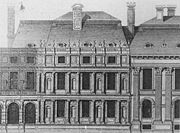
Jean Bullant
Encyclopedia

.jpg)
- See also: Jean Bullant (composer)
Jean Bullant (1515–1578) was a French
France
The French Republic , The French Republic , The French Republic , (commonly known as France , is a unitary semi-presidential republic in Western Europe with several overseas territories and islands located on other continents and in the Indian, Pacific, and Atlantic oceans. Metropolitan France...
architect
Architect
An architect is a person trained in the planning, design and oversight of the construction of buildings. To practice architecture means to offer or render services in connection with the design and construction of a building, or group of buildings and the space within the site surrounding the...
and sculptor
Sculpture
Sculpture is three-dimensional artwork created by shaping or combining hard materials—typically stone such as marble—or metal, glass, or wood. Softer materials can also be used, such as clay, textiles, plastics, polymers and softer metals...
who built the tombs of Anne de Montmorency
Anne de Montmorency
Anne de Montmorency, duc de Montmorency, Honorary Knight of the Garter was a French soldier, statesman and diplomat. He became Marshal of France and Constable of France.-Early life:...
, Grand Connétable of France, Henri II
Henry II of France
Henry II was King of France from 31 March 1547 until his death in 1559.-Early years:Henry was born in the royal Château de Saint-Germain-en-Laye, near Paris, the son of Francis I and Claude, Duchess of Brittany .His father was captured at the Battle of Pavia in 1525 by his sworn enemy,...
, and Catherine de' Medici
Catherine de' Medici
Catherine de' Medici was an Italian noblewoman who was Queen consort of France from 1547 until 1559, as the wife of King Henry II of France....
. He also worked on the Tuileries, the Louvre
Louvre
The Musée du Louvre – in English, the Louvre Museum or simply the Louvre – is one of the world's largest museums, the most visited art museum in the world and a historic monument. A central landmark of Paris, it is located on the Right Bank of the Seine in the 1st arrondissement...
, and the Château d'Écouen
Château d'Écouen
The Château d'Écouen is a historical building in Écouen, north of Paris, France. It was built in 1538–1550 for Anne de Montmorency, who was made connétable in 1538. He had inherited the château in 1515, and his building campaigns were informed by his first-hand experience in overseeing royal works...
. Bullant was a Huguenot
Huguenot
The Huguenots were members of the Protestant Reformed Church of France during the 16th and 17th centuries. Since the 17th century, people who formerly would have been called Huguenots have instead simply been called French Protestants, a title suggested by their German co-religionists, the...
.
On his return in 1537 from study in Rome, Bullant worked for Montmorency, for whom he transformed the Château d'Écouen
Château d'Écouen
The Château d'Écouen is a historical building in Écouen, north of Paris, France. It was built in 1538–1550 for Anne de Montmorency, who was made connétable in 1538. He had inherited the château in 1515, and his building campaigns were informed by his first-hand experience in overseeing royal works...
about 1550, built the "petit château" at Chantilly
Château de Chantilly
The Château de Chantilly is a historic château located in the town of Chantilly, France. It comprises two attached buildings; the Grand Château, destroyed during the French Revolution and rebuilt in the 1870s, and the Petit Château which was built around 1560 for Anne de Montmorency...
, and modernised the Château de Fère-en-Tardenois, with its splendid bridge.
He took up the on-going works at the Tuileries upon the death of Philibert Delorme (1570), and was appointed royal architect, (1571–78). At Chenonceaux he built the gallery that spans the river on arches (1576–1577). For Catherine de Médicis he built the Hôtel de Soissons, (1572–84; demolished in 1748), of which only the Medici column remains.
His treatise on architecture, La Règle générale d'architecture sur les cinq manières de colonnes, was published at Paris, 1564 and 1568. Bullant was also the author of treatises linking theory to practice, on geometry for craftsmen (Petit Traicté de géometrie et horlogiographie pratique, 1564), and horology, notably quadrants and solar clocks (Recueil d'Horlogiographie, 1561).
Further reading
- Charles Bauchal Nouveau dictionnaire des architectes français. Paris: André, Daly fils et Cie, 1887; p. 842
- F. Lemerle & Y. Pauwels, L'architecture à la Renaissance, Paris: Flammarion, Paris, 1998 (reissued 2004)
External links
- Bullant's treatises on line, François Rabelais UniversityFrançois Rabelais UniversityFrançois Rabelais University or University of Tours, is a public university in Tours, France. The university is named after the French writer François Rabelais, and was founded in 1969.-Organisation:...

